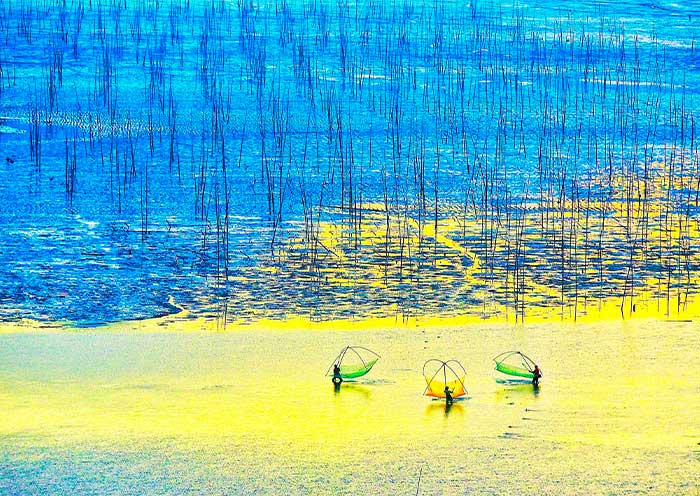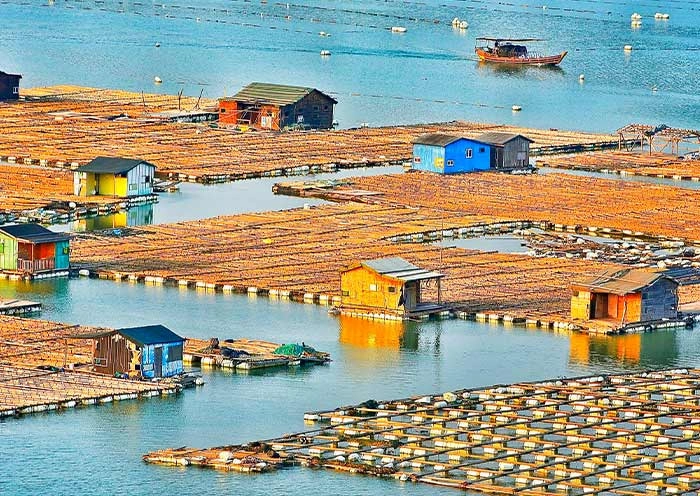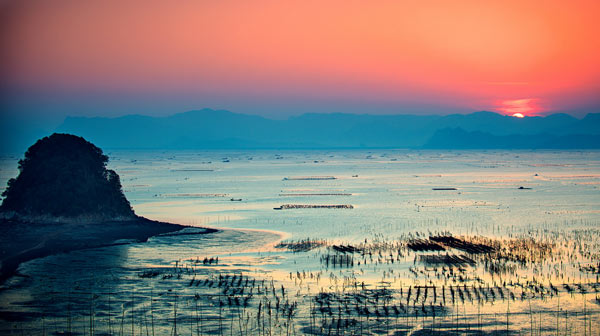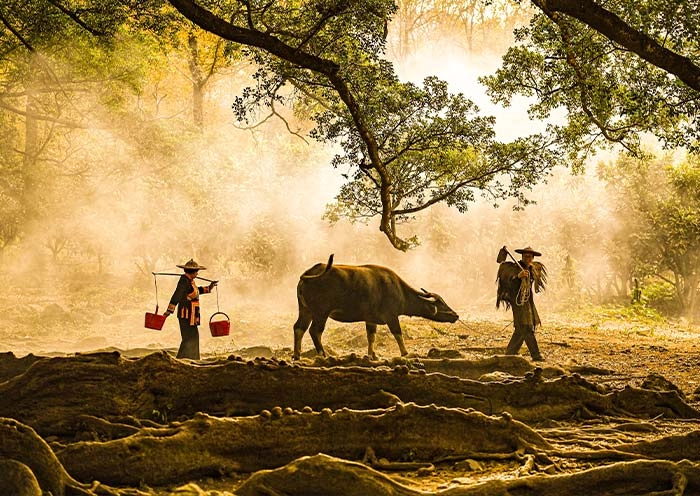Xiapu Mudflat: A Photographer’s Dream Destination Awaits

An Essential Guide to Visiting Xiapu Mudflat
Nestled along the southeastern coast of China in Fujian Province, Xiapu Mudflat offers an enchanting escape into a world where nature and traditional rural life intertwine seamlessly. This picturesque destination, often overlooked by international travelers, is a haven for photographers and nature enthusiasts alike. Here, the landscape is a dynamic canvas, painted daily by the ebb and flow of the tides that reveal a patchwork of shimmering waters and rich mudflats.
As the sun rises, fishermen set out in their small boats, their silhouettes creating a stunning contrast against the vibrant hues of dawn. The mudflats are alive with activity and wildlife—crabs scuttle across the sand, and egrets gracefully swoop down to feast on the bounty of the sea. Visitors can witness the age-old traditions of seaweed harvesting and fishing, offering a glimpse into the rustic charm of Chinese countryside life.
Xiapu is not just about breathtaking vistas; it’s a place where you can engage with the local community. Friendly villagers welcome you into their world, sharing stories over cups of tea and offering insights into their daily routines. Whether you choose to wander along the mudflats, hike through the lush hills, or savor the local cuisine in cozy inns, every moment spent in Xiapu is an invitation to slow down and appreciate the simple joys of life.
For those seeking a unique travel experience that combines stunning scenery, cultural immersion, and the serenity of rural living, Xiapu Mudflat is a must-visit destination that promises to leave a lasting impression. Prepare to capture not just photographs, but memories that will linger long after your journey has ended.
In This Guide
- An Essential Guide to Visiting Xiapu Mudflat
- The Rich History and Legends of Xiapu Mudflat
- Main Highlights: What You Absolutely Can’t Miss
- Planning Your Visit: A Practical Guide
- Tickets: Prices, Booking, and Tips
- How to Get There: A Complete Transportation Guide
- Local Cuisine and Accommodation Nearby
- Frequently Asked Questions
- Final Thoughts on Your Trip
The Rich History and Legends of Xiapu Mudflat
Nestled along the southeastern coast of China in Fujian Province, Xiapu Mudflat serves as a living testament to a time when the rhythms of nature dictated the livelihoods of local communities. This enchanting coastal expanse, stretching over 40 square kilometers, is not just a geographical marvel but also a rich tapestry of history and folklore.
Historically, the mudflats have been integral to the traditional way of life in Xiapu, where farming and fishing formed the backbone of the local economy for centuries. The area’s unique ecosystem, characterized by its ebbing and flowing tides, has fostered a vibrant community that harmoniously coexists with nature. The mudflats are alive with activity; as the tide recedes, the locals venture out to harvest seaweed, fish, and various shellfish, utilizing time-honored techniques passed down through generations.
The significance of Xiapu extends beyond its practical uses. The mudflats have inspired countless legends and tales, often woven into the fabric of local culture. One such story tells of the “Daughter of the Sea,” a mythical figure believed to bless fishermen with bountiful catches in exchange for their respect towards the ocean. This reverence for the sea is palpable among the community, where rituals and celebrations tied to the lunar calendar mark important fishing seasons.
Moreover, the historical architecture scattered throughout Xiapu adds depth to its allure. Ancient structures, such as the Dajing Castle, offer a glimpse into the region’s past, dating back over 700 years. This fortress stands as a silent guardian, witnessing the evolution of Xiapu from a humble fishing village to a vibrant cultural hub. The castle, with its intricate moat and well-preserved pathways, is a reminder of the strategic importance of this coastal area throughout Chinese history.
Xiapu Mudflat is also renowned for its stunning landscapes that have captivated artists and photographers alike, earning a place on lists of the world’s top photography destinations. The interplay of light and shadow across the mudflats creates a constantly changing canvas, reflecting the beauty of both nature and the labor of the local people. Every sunrise and sunset offers a new perspective, painting the mudflats in hues of gold and crimson, while the silhouettes of fishermen at work evoke a sense of nostalgia for a simpler, more connected way of life.
As you wander through Xiapu, you’ll encounter more than just breathtaking scenery; you’ll find a community deeply rooted in its traditions, where each tide brings stories of resilience and harmony with the environment. Engaging with the locals, you can learn about their daily lives, witness their time-honored practices, and perhaps even hear the legends that have shaped their identity.
Whether you’re an avid photographer or simply seeking a tranquil escape from the hustle of modern life, Xiapu Mudflat invites you to step into a world where history and nature intertwine, offering a unique glimpse into the heart of rural China.

Xiapu Mudflat.
Main Highlights: What You Absolutely Can’t Miss
Xiapu Mudflat is a captivating destination that offers a unique blend of stunning natural beauty and rich cultural experiences. Here are the key highlights that you absolutely can’t miss during your visit:
1. Breathtaking Sunrises and Sunsets
Start your day early to witness the magical sunrise over the mudflats, where the sun’s rays create a shimmering reflection on the water, transforming the landscape into a canvas of colors. As the day winds down, the sunset offers equally mesmerizing views, making it a photographer’s paradise. The interplay of light and shadow across the mudflats creates stunning photographic opportunities.
2. Local Fishing and Seaweed Harvesting
Experience the traditional way of life as local villagers engage in fishing and seaweed harvesting. From April to June, you can observe the bustling activity as fishermen work with egrets flying above, creating a picturesque scene reminiscent of Chinese ink paintings. Visiting Bailucun village during May will allow you to capture the vibrant seaweed drying on bamboo poles.
3. Yangjiaxi River
Take a bamboo raft ride down the tranquil Yangjiaxi River, especially in March and April. The river is lined with ancient banyan trees and rich maple forests, offering a peaceful escape into nature. The best time to visit is before 7 AM or after 5 PM, when no entrance fee is required, allowing you to soak in the serene atmosphere without a crowd.
4. Dajing Castle
Explore the historical Dajing Castle, which dates back over 700 years. This ancient fortification boasts an impressive moat and a well-preserved defense system. Wander through the flagstone roads that connect various pavilions and houses, immersing yourself in the region’s rich history while enjoying panoramic views of the surrounding landscape.
5. Photographic Opportunities
Xiapu Mudflat is acclaimed as one of the top destinations for photographers. With its tiger-striped beaches, bamboo structures, and the interplay of labor and nature, the area provides endless opportunities for stunning photography year-round. Don’t miss the chance to capture the unique sceneries shaped by the changing tides and local activities.
6. Culinary Delights at Local Inns
Take a break from exploring and savor the local cuisine at small inns and restaurants. Sample fresh seafood and traditional dishes prepared with local ingredients. Engaging with local villagers over a meal provides a deeper understanding of the culture and way of life in this rustic region.
7. Scenic Hiking Trails
For those who enjoy hiking, the hills surrounding Xiapu offer scenic trails with breathtaking views of the mudflats below. As you hike, take the time to appreciate the peaceful countryside, dotted with thatched huts and traditional farming practices. This is a great way to connect with nature and experience the rural lifestyle firsthand.
8. Interacting with Friendly Locals
Engage with the warm and welcoming villagers who call Xiapu home. Their stories and insights into their daily lives will enrich your experience and provide a deeper appreciation for this unique coastal community. Don’t hesitate to ask questions and learn about their traditional trades, from fishing to farming.
9. Unique Natural Landscapes
The constantly changing scenery of Xiapu Mudflat is a sight to behold. Observe the way the landscape morphs with the tides, revealing mud, water, and the creatures that thrive in this environment. The interaction of natural elements provides a dynamic backdrop for exploration and photography.
10. Cultural Immersion
Take part in local festivals and events if your visit coincides with them. Experience traditional music, dance, and crafts that reflect the rich heritage of this coastal community. Engaging in these cultural activities will give you an authentic glimpse into the life of Xiapu’s residents.
Visiting Xiapu Mudflat is more than just a trip; it’s an opportunity to immerse yourself in the simplicity and beauty of rural Chinese life. Each highlight offers a unique perspective of this enchanting destination, ensuring a memorable experience that resonates long after your visit.

Xiapu Mudflat.
Planning Your Visit: A Practical Guide
When planning your visit to Xiapu Mudflat, you’ll find a unique blend of stunning landscapes, rich local culture, and opportunities for immersive photography. This guide will help you navigate your journey to this hidden gem along the southeastern coastline of China.
Getting There
Xiapu is located about 150 kilometers (93 miles) north of Fuzhou, the capital of Fujian Province. Here are your options for reaching this picturesque destination:
-
By Car: If you’re driving, Xiapu is accessible from major cities such as Shanghai (approximately 7.5 hours), Wenzhou (2.5 hours), Xiamen (5 hours), and Fuzhou (2.5 hours). Given the rural nature of the area, renting a car or hiring a private driver is recommended for convenience.
-
By Train: Xiapu has its own train station with D-class trains running from Shanghai (5.5-6 hours) and Wenzhou (about 1 hour). The train ride offers a scenic view of the countryside.
Accommodation
While Xiapu may not boast high-end hotels, there are plenty of modest inns and guesthouses that cater to mainland tourists. Basic amenities like hot showers and air conditioning are generally available. For an authentic experience, consider staying in a local inn where you can engage with the community.
Best Time to Visit
The best time to visit Xiapu depends on what you wish to experience:
-
Spring (March – June): This season is ideal for capturing the vibrant life of local fishermen and the seaweed harvesting process. The picturesque scenes of bamboo drying racks filled with seaweed against the backdrop of the tidal flats are especially captivating.
-
Summer (July – September): While this is typhoon season, it also offers dramatic skies perfect for capturing stunning sunrises and sunsets. The changing weather can add a unique character to your photographs.
-
Autumn and Winter (October – February): This is the season for laver harvesting. The picturesque scenes of locals working in the mudflats, along with the beautiful colors of maple leaves, create a photographer’s paradise.
What to Experience
Xiapu boasts a variety of activities that allow you to connect with local culture and the natural environment:
-
Photography: Xiapu is renowned for its stunning landscapes, making it one of the “Top 10 Paradises for Photographers.” Capture the intricate patterns left by receding tides, the colorful boats, and the local workers in their daily routines.
-
Local Cuisine: Don’t miss the opportunity to dine at small inns and local restaurants where you can savor fresh seafood and traditional Fujian dishes. Engaging with local villagers can also lead to delightful culinary surprises.
-
Nature Walks: Hiking through the surrounding countryside will allow you to immerse yourself in the tranquil rural lifestyle. The paths winding through the hills offer breathtaking views of the mudflats and coastal scenery.
-
Cultural Insights: Take the time to converse with local villagers. They can offer insights into their traditional ways of life and the sustainable practices they utilize in farming and fishing.
Practical Tips
-
Language: English is not widely spoken, so consider hiring a local guide who can assist with translation and help navigate the area.
-
Transportation: Since public transport options are limited, having a private vehicle will enhance your experience. You can also hire taxis, although they may be less abundant in rural areas.
-
Cash: Ensure you have enough cash on hand, as many local establishments may not accept credit cards.
Conclusion
Xiapu Mudflat offers a serene escape from the bustling urban life of China, showcasing the beauty of rural traditions and the artistry of nature. Whether you’re a photographer seeking the perfect shot, a traveler eager to explore local culture, or someone simply looking to unwind in a peaceful setting, Xiapu is a destination that promises to leave a lasting impression. Embrace the charm of this unique region, and get ready for an enriching journey into the heart of China’s coastal life.

Xiapu Mudflat.
Tickets: Prices, Booking, and Tips
When planning your visit to Xiapu Mudflat, it’s essential to know the ticketing details to make your experience seamless and enjoyable. Here’s what you need to know about prices, booking, and some handy tips to enhance your trip.
Ticket Information
Entry Fees
- Xiapu Mudflat: Generally, access to the mudflats is free, allowing visitors to explore the stunning scenery and local life without an entry fee. However, certain specific areas or attractions within the region may charge a nominal fee, so it’s wise to carry some cash just in case.
- Yangjiaxi River: If you plan to visit this picturesque river, note that entrance is free before 7 AM and after 5 PM. During peak hours, a small fee may be required.
Booking Tips
- Transportation Reservations: Since Xiapu is off the beaten path for international tourists and lacks an extensive public transport system, consider booking a private vehicle or hiring a local driver. This will allow you to explore the area at your own pace and access hidden gems that may not be reachable by public transport.
- Guided Tours: If you prefer a structured experience, look for guided tours that include transportation and a knowledgeable guide. This can make your trip more enriching, as they can provide insights into the local culture and landscape.
- Accommodations: While Xiapu does not boast luxury hotels, there are several quaint inns and guesthouses catering to mainland tourists. Booking in advance is advisable, especially during peak seasons when photographers flock to capture the breathtaking scenery.
Practical Tips
- Best Time to Visit: The mudflats are spectacular year-round, but the best times for photography and experiencing local life vary by season. Plan your visit according to the activities you wish to capture; for instance, seaweed harvesting takes place from April to June.
- Cash is King: While some places may accept cards, it’s best to have cash on hand for small purchases and local eateries. Most transactions in Xiapu are conducted in cash.
- Respect Local Customs: Engage with the friendly local communities when exploring. They are often willing to share stories about their traditional ways of life, enhancing your travel experience.
- Photography: Bring your camera, as Xiapu Mudflat is a photographer’s paradise. Early mornings and late afternoons provide the best lighting for capturing the stunning landscapes and local activities.
By keeping these ticketing details and tips in mind, your visit to Xiapu Mudflat will be both enjoyable and memorable. Whether you’re wandering through the mudflats at sunrise or savoring local dishes at a quaint inn, every moment in this rural gem of Fujian Province promises to be a rewarding experience.
How to Get There: A Complete Transportation Guide
To embark on your journey to the picturesque Xiapu Mudflat, nestled in Fujian Province, you’ll find multiple transportation options that cater to different travel preferences. Whether you’re arriving from major cities or exploring the scenic countryside, here is a comprehensive guide to help you reach this tranquil destination.
By Air
Closest Airport:
The nearest major airport is Fuzhou Changle International Airport (FOC), located about 175 kilometers (approximately 109 miles) from Xiapu.
Traveling from the Airport to Xiapu:
– By Taxi: The most convenient option is to take a taxi directly to Xiapu, which takes around 2.5 to 3 hours, depending on traffic. Expect to pay around ¥400-¥500.
– By Train: Alternatively, you can take a high-speed train from Fuzhou to Xiapu. First, take a taxi or shuttle bus to Fuzhou Train Station (about 50 minutes from the airport). From there, the train journey to Xiapu takes approximately 1.5 hours.
By Train
Xiapu has its own train station, making it accessible via China’s extensive rail network.
From Major Cities:
– Shanghai: D-class trains from Shanghai reach Xiapu in about 5.5 to 6 hours.
– Wenzhou: If you’re coming from Wenzhou, direct trains take only about 1 hour.
– Xiamen/Fuzhou: Both cities have frequent train connections, with travel times ranging from 2.5 to 5 hours, depending on your origin.
Travel Tips:
Book your tickets in advance, especially during peak travel seasons, to secure your preferred departure times.
By Road
For those who prefer the flexibility of a private vehicle or guided tour, traveling by car is a fantastic way to soak in the scenic landscapes of Fujian Province.
Driving Distances from Major Cities:
– Xiamen: Approximately 5 hours (around 300 kilometers or 186 miles)
– Fuzhou: Approximately 2.5 hours (about 175 kilometers or 109 miles)
– Wenzhou: Approximately 2.5 hours (around 160 kilometers or 99 miles)
– Shanghai: Approximately 7.5 hours (around 700 kilometers or 435 miles)
Car Rentals and Drivers:
While car rentals are available, consider hiring a local driver who can navigate rural roads and serve as a translator during your visit.
Local Transportation
Once you arrive in Xiapu, transportation options are more limited compared to urban areas.
- Taxis: Taxis are available but fewer in number, so waiting times may vary.
- Buses: Local buses operate routes to nearby attractions, including Yangjiaxi River and Beiqicun village. The fare is generally inexpensive, around ¥3-¥8.
- Biking and Walking: Exploring the mudflats and surrounding villages on foot or by bicycle is a delightful way to immerse yourself in the local scenery and culture.
Final Thoughts
Whether you choose to arrive by train, plane, or car, your journey to Xiapu Mudflat will lead you to a captivating slice of rural China. With its stunning landscapes, vibrant local life, and rich cultural heritage, Xiapu offers a unique experience that captures the essence of traditional Chinese coastal living. Don’t forget to bring your camera—this hidden gem is a photographer’s paradise!

Xiapu Mudflat.
Local Cuisine and Accommodation Nearby
When visiting the enchanting Xiapu Mudflat, immerse yourself in the region’s rich culinary offerings and cozy accommodations that reflect the local culture. Here’s a delightful guide to satisfy your taste buds and ensure a comfortable stay while exploring this picturesque area.
Local Cuisine
Xiapu’s unique geography and traditional fishing practices provide a bounty of fresh seafood and local delicacies. Here are some must-try dishes and popular dining spots:
-
Seaweed Dishes: Xiapu is renowned for its high-quality seaweed, often featured in soups and stir-fries. Look for local restaurants that serve dishes such as seaweed soup and stir-fried seaweed with garlic, which showcase the region’s flavors.
-
Fresh Seafood: Enjoy an array of freshly caught seafood, including tender squid, succulent shrimp, and various fish. Visit any of the small seafood restaurants along the coast where you can choose your meal from tanks and have it cooked to order. The grilled squid and steamed fish with ginger are particularly recommended.
-
Laver (Nori): This area is known for its laver, which is harvested between October and February. Sample laver pancakes or soups, which are not only delicious but also offer a glimpse into the local culinary traditions.
-
Local Snacks: Don’t miss out on trying traditional snacks like sweet potato cakes (地瓜饼) and tea-flavored cakes (茶饼), often sold by local vendors. These treats make for a perfect accompaniment to a cup of local tea during your leisurely breaks.
Recommended Dining Spots
-
Xiapu Seafood Restaurant (霞浦海鲜酒楼): Known for its vibrant atmosphere and fresh catch, this restaurant serves a variety of seafood dishes that highlight the region’s culinary heritage.
-
Bailucun Village Restaurant (白璐村餐馆): Located near one of the main seaweed production areas, this eatery specializes in seaweed dishes and offers stunning views of the mudflats.
-
Local Street Stalls: For an authentic experience, venture into the streets where you can find stalls selling local snacks and quick bites, perfect for a casual meal on the go.
Accommodation Options
While Xiapu may not boast luxury hotels, it offers charming and comfortable accommodations that reflect the local culture:
-
Xiapu Mudflat Hotel (霞浦滩涂酒店): This hotel provides cozy rooms with beautiful views of the mudflats. It offers basic amenities like hot showers and air conditioning, making it a comfortable base for your explorations.
-
Local Guesthouses: Experience hospitality like no other by staying in one of the local guesthouses. Many are family-run and provide a warm atmosphere that allows you to connect with the community. Enjoy home-cooked meals and insightful conversations with your hosts.
-
Bamboo Huts: For a more rustic experience, consider staying in traditional bamboo huts available in some villages. These accommodations offer a unique experience and bring you closer to nature, with the sounds of the tide lulling you to sleep.
-
Farm Stays: Engage with the local lifestyle by opting for a farm stay. These accommodations not only provide a comfortable place to rest but also allow you to participate in daily activities like fishing and harvesting, providing an enriching experience.
Conclusion
Xiapu Mudflat is not just a visual feast for photographers but a culinary treasure trove that awaits discovery. With its delectable seafood, local specialties, and warm, inviting accommodations, you’re sure to leave with unforgettable memories of both the sights and flavors of this charming coastal region. Whether you are savoring fresh dishes in a local restaurant or winding down in a cozy guesthouse, Xiapu promises an authentic experience that resonates long after your visit.

Xiapu Mudflat.
Frequently Asked Questions
Frequently Asked Questions About Xiapu Mudflat
- What is the best time to visit Xiapu Mudflat for photography?
-
The ideal times for photography vary throughout the year. For capturing the vibrant seaweed harvest, visit from April to June. If you’re interested in stunning sunrise and sunset shots, consider July to September. The laver harvest occurs from October to February, showcasing local culture and scenic beauty.
-
How can I get to Xiapu Mudflat from nearby cities?
-
Xiapu is accessible by car or train. It is about 2.5 hours from Fuzhou, 7.5 hours from Shanghai, and 5 hours from Xiamen by car. Alternatively, you can take a D class train, with travel times of about 5.5 to 6 hours from Shanghai and approximately 1 hour from Wenzhou.
-
Are there accommodations available in Xiapu?
-
Yes, Xiapu offers a range of accommodations, primarily catering to mainland tourists. While they may not be luxurious, you can expect basic amenities like air conditioning and hot showers. It’s advisable to book in advance, especially during peak tourist seasons.
-
What activities can I enjoy while visiting Xiapu?
-
Besides photography, visitors can explore rural life by walking along the mudflats, hiking among local villages, or enjoying fresh seafood at small inns and restaurants. Engaging with local fishermen and farmers provides a unique insight into traditional Chinese countryside life.
-
Is it necessary to hire a guide for my visit?
-
While it’s not mandatory, hiring an experienced guide can enhance your visit significantly. They can provide valuable insights into local culture, assist with translations, and help you navigate the less touristy areas of Xiapu.
-
What should I wear when visiting the mudflats?
-
Dress comfortably, considering the weather and the muddy terrain. Lightweight, breathable clothing is ideal, along with sturdy shoes or boots that can handle muddy conditions. A hat and sunscreen are recommended for sun protection.
-
Are there any local specialties or foods I should try?
-
Be sure to sample fresh seafood dishes, particularly those featuring seaweed and laver, which are local specialties. Small inns and restaurants often serve delicious and authentic meals made with fresh, locally sourced ingredients.
-
Can I visit Xiapu Mudflat year-round?
- Yes, Xiapu Mudflat is open year-round, with each season offering unique experiences. However, it’s wise to check weather conditions and local events, especially during typhoon season (July to September), as this may impact travel plans.
Final Thoughts on Your Trip
As you wrap up your journey through the captivating Xiapu Mudflat, take a moment to reflect on the beauty and simplicity that this unique destination offers. Here, the tides tell a story of resilience and harmony between nature and the traditional ways of life that have persisted for generations. From the mesmerizing interplay of light at dawn to the vibrant tapestry of local fishermen at work, every corner of Xiapu serves as a reminder of the profound connection between humanity and the environment.
This is not just a destination for stunning photography; it’s a place to immerse yourself in the authentic rhythms of rural Chinese life. Engage with the friendly locals, savor the fresh flavors of the sea, and allow the serene landscapes to wash away the hustle of modern life. Whether you’re wandering through the picturesque villages, enjoying a quiet moment by the coast, or capturing the essence of the mudflats on camera, Xiapu invites you to slow down and appreciate the simpler things.
As you depart, carry with you the memories of shimmering waters, the laughter of villagers, and the colorful scenes that unfold with each changing tide. Xiapu is more than just a stop on your travels; it’s a beautiful chapter in your story of exploration. Embrace the tranquility, cherish the connections, and let the spirit of Xiapu linger in your heart long after you leave its shores.